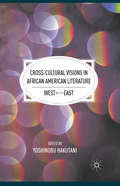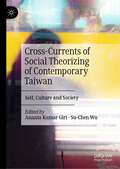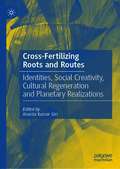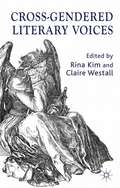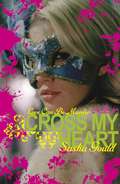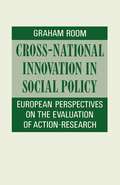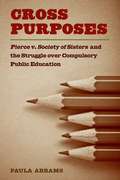- Table View
- List View
Cross-Cultural Visions in African American Literature: West Meets East
by Yoshinobu HakutaniThe most influential East-West artistic, cultural, and literary exchange that has taken place in modern and postmodern times was the reading and writing of haiku. Here, esteemed contributors investigate the impact of Eastern philosophy and religion on African American writers such as Richard Wright, Ralph Ellison, and Toni Morrison, offering a fresh field of literary inquiry.
Cross-Currents of Social Theorizing of Contemporary Taiwan: Self, Culture and Society
by Ananta Kumar Giri Su-Chen WuThe book presents aspects of cross-currents of theorizing of self, culture and society in the contemporary Taiwan. Social theorizing has been addressed critically, reflectively and creatively by the philosophical, religious, psychological and literary traditions of one of the world’s great civilizations Theorizing is a dynamic movement of self, culture, society and the world as it is related to our actions, reflections, meditations to understand the world more meaningfully and holistically as well as to transform it. But much of social theorizing in the modern world is primarily Euro-American and despite the socalled globalization of knowledge, this condition of one-sided Euro-American valorization of knowledge and neglect of others continues unabated. There is very little attention to theorizing about the human condition emerging from other parts of the world such as Taiwan and its global implication. This book transforms this condition by mapping the field of theorizing in a wider spectrum of philosophy, psychology, religions, social sciences and humanities in contemporary Taiwan.
Cross-dressing in Turkish Cinema: Politics, Gender and National Trauma
by Burcu DabakAs in western cinema, cross-dressing is a recurrent theme in Turkish film. But what do these films, whose characters typically cross-dress in order to escape enemies or other threats, tell us about the modern history of the Turkish Republic?This book examines cross-dressing in Turkish films in the context of formative events in modern Turkish political history, arguing that this trope coincides with and is illustrative of trauma induced by Turkey's multiple coup d'etats, periods of authoritarianism, enforced secularism and 'modernization'.Burcu Dabak Ozdemir analyses five case study films wherein she reveals that cross-dressing characters are able to escape persecutors and surveillance - key instruments of oppression during Turkey's coups. She shows how cross-dressing in the films examined become a destabilising force, a form of implicit resistance against state power, both political and in terms of binaries of gender and identity, and a means to register moments of national trauma. The book historicises the concept of cross-dressing in modern Turkey by examining what the author argues is a formative trauma worked through in the films examined: the westernization policies of the Kemalist regime whose most immediate symbolic presence was worn - the enforced adoption of western dress by citizens.Of interest to scholars of gender, queer, film and trauma studies, the book will also appeal to students and scholars of contemporary Turkish culture and society.
Cross-dressing in Turkish Cinema: Politics, Gender and National Trauma
by Burcu DabakAs in western cinema, cross-dressing is a recurrent theme in Turkish film. But what do these films, whose characters typically cross-dress in order to escape enemies or other threats, tell us about the modern history of the Turkish Republic?This book examines cross-dressing in Turkish films in the context of formative events in modern Turkish political history, arguing that this trope coincides with and is illustrative of trauma induced by Turkey's multiple coup d'etats, periods of authoritarianism, enforced secularism and 'modernization'.Burcu Dabak Ozdemir analyses five case study films wherein she reveals that cross-dressing characters are able to escape persecutors and surveillance - key instruments of oppression during Turkey's coups. She shows how cross-dressing in the films examined become a destabilising force, a form of implicit resistance against state power, both political and in terms of binaries of gender and identity, and a means to register moments of national trauma. The book historicises the concept of cross-dressing in modern Turkey by examining what the author argues is a formative trauma worked through in the films examined: the westernization policies of the Kemalist regime whose most immediate symbolic presence was worn - the enforced adoption of western dress by citizens.Of interest to scholars of gender, queer, film and trauma studies, the book will also appeal to students and scholars of contemporary Turkish culture and society.
Cross-Fertilizing Roots and Routes: Identities, Social Creativity, Cultural Regeneration and Planetary Realizations
by Ananta Kumar GiriThe book discusses how we can cross-fertilize relationship between roots and routes with and beyond the logic of closure, monological assertions and violence. The book draws upon multiple philosophical, historical, religious and spiritual traditions of the world to rethink our conceptions and productions of identity as well as our conventional understanding of roots and routes. The book particularly explores the vision and practice of creativity, socio-cultural regeneration and planetary realizations to cultivate new pathways of identity realization and new relationship between identities and differences in our fragile world today. Trans-disciplinary in engagement and trans-civilizational in its dialogical pathway, the book is a unique contribution to our contemporary scholarship about ethnicity, identity, social creativity, cultural regeneration and planetary realizations.
Cross-Gender China: Across Yin-Yang, Across Cultures, and Beyond Jingju (Routledge Advances in Theatre & Performance Studies)
by Huai BaoCross-Gender China, the outcome of more than twenty years of theatrical and sociological research, deconstructs the cultural implications of cross-gender performance in today's China. The recent revival in male-to-female cross-gender nandan performance in Chinese theatre raises a multitude of questions: it may suggest new gender dynamics, or new readings of old aesthetic traditions in new socio-cultural contexts. Interrogating the positions of the gender being performed and the gender doing the performing, this volume gives a broad cultural account of the contexts in which this unique performance style has found new life.
Cross-Gender China: Across Yin-Yang, Across Cultures, and Beyond Jingju (Routledge Advances in Theatre & Performance Studies)
by Huai BaoCross-Gender China, the outcome of more than twenty years of theatrical and sociological research, deconstructs the cultural implications of cross-gender performance in today's China. The recent revival in male-to-female cross-gender nandan performance in Chinese theatre raises a multitude of questions: it may suggest new gender dynamics, or new readings of old aesthetic traditions in new socio-cultural contexts. Interrogating the positions of the gender being performed and the gender doing the performing, this volume gives a broad cultural account of the contexts in which this unique performance style has found new life.
Cross-Gendered Literary Voices: Appropriating, Resisting, Embracing
by Rina Kim and Claire WestallThis book investigates male writers' use of female voices and female writers' use of male voices in literature and theatre from the 1850s to the present, examining where, how and why such gendered crossings occur and what connections may be found between these crossings and specific psychological, social, historical and political contexts.
The Cross Legged Knight: The Owen Archer Series - Book Eight (An\owen Archer Mystery Ser. #Bk. 8)
by Candace RobbEngland 1371: a solemn convoy wends its way into York. William of Wykeham, Bishop of Winchester, is bringing home the remains of Sir Ranulf Pagnell, patriarch of a powerful local family, who has died in France. But the family hold the bishop responsible for Sir Ranulf's death, and ill feeling surrounds his arrival. An accident in the grounds of York Minster nearly kills the bishop. Then, only a few days after, his townhouse is found ablaze. When the body of a young woman is discovered in the undercroft of the house, scandal threatens to destroy Wykeham. The Archbishop of York, John Thoresby, asks Owen Archer for his help. The one-eyed spy is troubled. Was the fire an accident or arson? Was the woman trapped or the fire started to conceal a corpse? Stationing guards in front of the smouldering remains, he starts to ask questions. When it appears the dead woman was a midwife known to many of the city's women, including Lucie, Owen's wife, his quest becomes personal.
Cross My Heart (Cross My Heart Ser.)
by Sasha GouldLaura della Scala knows nothing beyond the convent walls which have trapped and bound her since she was twelve years old. A single night will change her life. She will soon learn the difference between an arranged marriage and true, reckless love.Venice is a dangerous city. Intrigue, romance and power lie at its heart and secrets run through the blood of its rulers.They call Laura 'La Muta'. The Silent One. She is about to break her silence . . .but at what cost?
Cross My Heart: And Hope To Live
by Carmen ReidBrussels, 1940. Fifteen-year-old Nicole watches as the Nazis invade Belgium. Determined not to stand by as her country is brought to its knees, Nicole vows to fight back and joins the Belgian Resistance. Under her new alias - Coco - Nicole embarks on a dangerous new life as a spy, where the only question is not if you'll be caught, but when...
Cross-National Innovation In Social Policy: European Perspectives On The Evaluation Of Action-Research (pdf)
by Graham RoomCross Of Fire: Master of War, Book 6 (Master of War #6)
by David GilmanWINTER, 1362 After decades of successful campaigning in France, Thomas Blackstone, once a common archer, has risen to become Edward III's Master of War.But the title is as much a curse as a blessing. Success has brought few rewards: his family – bar his son Henry – is dead, slaughtered; his enemies only multiply. Death, in so many guises, beckons.As he battles to enforce his King's claim to French territory, Blackstone will assault an impregnable fortress, he'll become embroiled in a feud between French aristocrats, he'll be forced into pitched battle in the dead of winter... and he'll be asked to pay an impossible price to protect something much more precious to the King than mere land.All the while, out of the east, a group of trained killers, burning with vengeance, draw ever closer.Praise for David Gilman: 'The level of suspense is ratcheted up to a truly brutal level' SHARON PENMAN'A gripping ride' WILBUR SMITH'Gilman does heart pounding action superlatively' THE TIMES'Like a punch from a mailed fist, Master of War is a gripping chronicle of pitched battle, treachery and cruelty' ROBERT FABBRI
Cross of Fire: A Pirate Devlin Novel (The Pirate Devlin #4)
by Mark KeatingThe pirate Olivier Levasseur, 'the Buzzard', has captured the greatest ship ever to sail the high seas, the Virgin of the Cape, a Portuguese ship carring a solid gold cross seven feet long. The Fiery Cross of Goa. Levasseur is hiding somewhere in the Indian Ocean, but Patrick Devlin is on his tail. However, Devlin's former master, and bitter enemy, John Coxon, has been sent to kill him . . .CROSS OF FIRE sees Devlin traverse Guinea and the slave coasts of Africa and the pirate islands of the Seychelles with the Royal Navy blocking his path, his old pirate enemies hunting him and his murderous former master hot on his heels.
Cross Of St George: (Richard Bolitho: Book 24) (Richard Bolitho #24)
by Alexander KentFebruary 1813With convoys from Canada and the Caribbean falling victim to American privateers, Sir Richard Bolitho returns to Halifax to pursue a war he knows will not be won, but which neither Britain nor the United States can afford to lose.England's youngest admiral desires only peace. But peace will not be found in the icy Canadian waters, where a young, angry nation asserts its identity and men who share a common heritage die in close and bloody action. Nor will there be a peace for those who follow the Cross of St George: for the embittered Adam, mourning his lover and his ship, nor for Rear-Admiral Valentine Keen, who must confront both grief and responsibility. Nor will there be peace from those enemies who use this struggle between nations as an instrument of personal revenge.
Cross-Party Politics in Britain, 1945-2019
by Dr Alan WagerBritish politics has long been conceived of as fundamentally a majoritarian, two-party game. The coalition government, and years of politicians working across party lines on Brexit, were both thought of as deviations from the norm. Yet since the Second World War, and the new party system that came with it, this kind of co-operation between parties has been mooted more often than folk memory would suggest. From Winston Churchill to Nick Clegg, Tony Blair to Nigel Farage, elite British politicians have privately and publicly toyed with the concept of co-operating with their competitors. Cross-Party Politics in Britain, 1945-2019 takes a historical-comparative look at seven such cases from the last 80 years. By retracing tales of failure as well as success, this book examines moments overlooked by historians of contemporary Britain, and most are examined through the lens of political science for the first time. Piecing together internal papers and memos from the archives as well as interviews with many of the key players, this book explores two questions. Why are politicians so often swimming against the tide when trying to co-operate with their competitors, even when it appears rational to do so? And, despite the challenges imposed by the Westminster Model, what is it that motivates those that try? The answers to these questions put recent developments in British politics in historical perspective, and provide clues as to what might happen when the idea of co-operation rears its head once again as the next general election approaches.
Cross-Party Politics in Britain, 1945-2019
by Dr Alan WagerBritish politics has long been conceived of as fundamentally a majoritarian, two-party game. The coalition government, and years of politicians working across party lines on Brexit, were both thought of as deviations from the norm. Yet since the Second World War, and the new party system that came with it, this kind of co-operation between parties has been mooted more often than folk memory would suggest. From Winston Churchill to Nick Clegg, Tony Blair to Nigel Farage, elite British politicians have privately and publicly toyed with the concept of co-operating with their competitors. Cross-Party Politics in Britain, 1945-2019 takes a historical-comparative look at seven such cases from the last 80 years. By retracing tales of failure as well as success, this book examines moments overlooked by historians of contemporary Britain, and most are examined through the lens of political science for the first time. Piecing together internal papers and memos from the archives as well as interviews with many of the key players, this book explores two questions. Why are politicians so often swimming against the tide when trying to co-operate with their competitors, even when it appears rational to do so? And, despite the challenges imposed by the Westminster Model, what is it that motivates those that try? The answers to these questions put recent developments in British politics in historical perspective, and provide clues as to what might happen when the idea of co-operation rears its head once again as the next general election approaches.
Cross Purposes: Pierce v. Society of Sisters and the Struggle over Compulsory Public Education
by Paula Abrams"A definitive study of an extremely important, though curiously neglected, Supreme Court decision, Pierce v. Society of Sisters." ---Robert O'Neil, Professor of Law Emeritus, University of Virginia School of Law "A careful and captivating examination of a dramatic and instructive clash between nationalism and religious pluralism, and of the ancient but ongoing struggle for control over the education of children and the formation of citizens." ---Richard W. Garnett, Professor of Law and Associate Dean, Notre Dame Law School "A well-written, well-researched blend of law, politics, and history." ---Joan DelFattore, Professor of English and Legal Studies, University of Delaware In 1922, the people of Oregon passed legislation requiring all children to attend public schools. For the nativists and progressives who had campaigned for the Oregon School Bill, it marked the first victory in a national campaign to homogenize education---and ultimately the populace. Private schools, both secular and religious, vowed to challenge the law. The Catholic Church, the largest provider of private education in the country and the primary target of the Ku Klux Klan campaign, stepped forward to lead the fight all the way to the U.S. Supreme Court. In Pierce v. Society of Sisters (1925), the court declared the Oregon School Bill unconstitutional and ruled that parents have the right to determine how their children should be educated. Since then, Pierce has provided a precedent in many cases pitting parents against the state. Paula Abrams is Professor of Constitutional Law at Lewis & Clark Law School.
Cross section of the Globe Theatre (Large Print)
by Rnib BookshareThis diagram shows a vertical cross section of the Globe Theatre, revealing the interior of the building. There is a locator dot shown, which will be at the top left of the page when the image is the right way up. At the top centre of the page is a triangular shaped roof over the stage, in the middle of which is a square window. Down the page are two carved pillars. Near the bottom of the page, an actor stands on the stage with a door to either side. The bases of the two pillars are to the left and right of these. On the left and right of the page are balconies attached to the walls of the theatre. There are people standing on the floor at the bottom of the page and on the balconies.
Cross section of the Globe Theatre (UEB Contracted)
by Rnib BookshareThis diagram shows a vertical cross section of the Globe Theatre, revealing the interior of the building. There is a locator dot shown, which will be at the top left of the page when the image is the right way up. At the top centre of the page is a triangular shaped roof over the stage, in the middle of which is a square window. Down the page are two carved pillars. Near the bottom of the page, an actor stands on the stage with a door to either side. The bases of the two pillars are to the left and right of these. On the left and right of the page are balconies attached to the walls of the theatre. There are people standing on the floor at the bottom of the page and on the balconies.
Cross section of the Globe Theatre (UEB Uncontracted)
by Rnib BookshareThis diagram shows a vertical cross section of the Globe Theatre, revealing the interior of the building. There is a locator dot shown, which will be at the top left of the page when the image is the right way up. At the top centre of the page is a triangular shaped roof over the stage, in the middle of which is a square window. Down the page are two carved pillars. Near the bottom of the page, an actor stands on the stage with a door to either side. The bases of the two pillars are to the left and right of these. On the left and right of the page are balconies attached to the walls of the theatre. There are people standing on the floor at the bottom of the page and on the balconies.
Cross section of the Great Pyramid at Giza (Large Print)
This is an image of a cross section of the Great Pyramid at Giza. It is a multi-page image set on two pages, a key and then the diagram page. A locator dot and title are shown on both pages. These must always be at the top left of the page when the image is the right way up.Key to cross section of the Great Pyramid at Giza: This page shows the abbreviations and textures used on the image of a cross section of the Great Pyramid. The abbreviations are in a column on the left of the page and textures or colours on the right of the page. This is an image of a cross section of the Great Pyramid at Giza. It is a multi-page image set on two pages, a key and then the diagram page. A locator dot and title are shown on both pages. These must always be at the top left of the page when the image is the right way up.Key to cross section of the Great Pyramid at Giza: This page shows the abbreviations and textures used on the image of a cross section of the Great Pyramid. The abbreviations are in a column on the left of the page and textures or colours on the right of the page.Cross section of the Great Pyramid at Giza: In this image of a cross section through the Great Pyramid, the main passages, galleries and chambers are shown. A dashed line border surrounds the image, and a scale line is shown in a box in the top right corner. The pointed top of the pyramid is at the top centre of the image, and the white limestone slab sides slope down to the left and right to meet the ground on which the pyramid is built. A break in the pyramid outline just above the ground on the right indicates the pyramid entrance. From here, a short passage leads into the pyramid, with other passages branching off this to the galleries and chambers. The ascending passage leads up into the higher part of the pyramid, where the grand gallery and king's chamber can be reached in the centre of the pyramid. The king's chamber is a highly decorated room lined with pink Aswan granite. The smaller queen's chamber is reached along a horizontal passage which branches off the ascending passage just where the grand gallery is reached. The queen's chamber lies down and to the right of the king's chamber. The descending passage which starts near the pyramid entrance leads underground to a small subterranean chamber, and up and right from this a shaft can also be found.
Cross section of the Great Pyramid at Giza (UEB Contracted)
This is an image of a cross section of the Great Pyramid at Giza. It is a multi-page image set on two pages, a key and then the diagram page. A locator dot and title are shown on both pages. These must always be at the top left of the page when the image is the right way up.Key to cross section of the Great Pyramid at Giza: This page shows the abbreviations and textures used on the image of a cross section of the Great Pyramid. The abbreviations are in a column on the left of the page and textures or colours on the right of the page. This is an image of a cross section of the Great Pyramid at Giza. It is a multi-page image set on two pages, a key and then the diagram page. A locator dot and title are shown on both pages. These must always be at the top left of the page when the image is the right way up.Key to cross section of the Great Pyramid at Giza: This page shows the abbreviations and textures used on the image of a cross section of the Great Pyramid. The abbreviations are in a column on the left of the page and textures or colours on the right of the page.Cross section of the Great Pyramid at Giza: In this image of a cross section through the Great Pyramid, the main passages, galleries and chambers are shown. A dashed line border surrounds the image, and a scale line is shown in a box in the top right corner. The pointed top of the pyramid is at the top centre of the image, and the white limestone slab sides slope down to the left and right to meet the ground on which the pyramid is built. A break in the pyramid outline just above the ground on the right indicates the pyramid entrance. From here, a short passage leads into the pyramid, with other passages branching off this to the galleries and chambers. The ascending passage leads up into the higher part of the pyramid, where the grand gallery and king's chamber can be reached in the centre of the pyramid. The king's chamber is a highly decorated room lined with pink Aswan granite. The smaller queen's chamber is reached along a horizontal passage which branches off the ascending passage just where the grand gallery is reached. The queen's chamber lies down and to the right of the king's chamber. The descending passage which starts near the pyramid entrance leads underground to a small subterranean chamber, and up and right from this a shaft can also be found.
Cross section of the Great Pyramid at Giza (UEB Uncontracted)
This is an image of a cross section of the Great Pyramid at Giza. It is a multi-page image set on two pages, a key and then the diagram page. A locator dot and title are shown on both pages. These must always be at the top left of the page when the image is the right way up.Key to cross section of the Great Pyramid at Giza: This page shows the abbreviations and textures used on the image of a cross section of the Great Pyramid. The abbreviations are in a column on the left of the page and textures or colours on the right of the page. This is an image of a cross section of the Great Pyramid at Giza. It is a multi-page image set on two pages, a key and then the diagram page. A locator dot and title are shown on both pages. These must always be at the top left of the page when the image is the right way up.Key to cross section of the Great Pyramid at Giza: This page shows the abbreviations and textures used on the image of a cross section of the Great Pyramid. The abbreviations are in a column on the left of the page and textures or colours on the right of the page.Cross section of the Great Pyramid at Giza: In this image of a cross section through the Great Pyramid, the main passages, galleries and chambers are shown. A dashed line border surrounds the image, and a scale line is shown in a box in the top right corner. The pointed top of the pyramid is at the top centre of the image, and the white limestone slab sides slope down to the left and right to meet the ground on which the pyramid is built. A break in the pyramid outline just above the ground on the right indicates the pyramid entrance. From here, a short passage leads into the pyramid, with other passages branching off this to the galleries and chambers. The ascending passage leads up into the higher part of the pyramid, where the grand gallery and king's chamber can be reached in the centre of the pyramid. The king's chamber is a highly decorated room lined with pink Aswan granite. The smaller queen's chamber is reached along a horizontal passage which branches off the ascending passage just where the grand gallery is reached. The queen's chamber lies down and to the right of the king's chamber. The descending passage which starts near the pyramid entrance leads underground to a small subterranean chamber, and up and right from this a shaft can also be found.
A cross section of the left side of the lower floors of a Victorian house (large print)
by RnibThis image shows a side view of a cross section through a Victorian house. There is a locator dot shown, which will be at the top left of the page when the image is the right way up. In the bottom left of the image the ground level is marked. To the right in the basement of the house is the scullery with a small window shown as a dashed line. To the right of the window in the scullery is a big sink with two taps. There is a water jug on the work surface. To the right are containers on shelves attached to the wall. To the right on the floor is a bucket, a washing basket and a brush. The drawing room on the next floor up has a large window on the left. Right of this is a stool and a piano with the lid open. Two of the stool's four legs and two of the piano's three legs are shown. Up and right from here is a picture hanging on the wall in a decorative frame. To the right is a door to another room. In the middle of the image is a fireplace with a circular mirror hanging on the wall up from it. Right from here are some lights hanging from the ceiling. Down from them is a soft chair with two of its four legs shown. On the right of the image is a large cupboard and then another large window. On the first floor on the left is a window. To the right is a wardrobe with double doors. To its right is a chest of drawers with a picture hanging on the wall in a decorative frame up from it. Right from this is a large four-poster bed with the drapes pulled aside. To the right is the nursery, a small room with a cot which has a hood. There is a window to the right.
